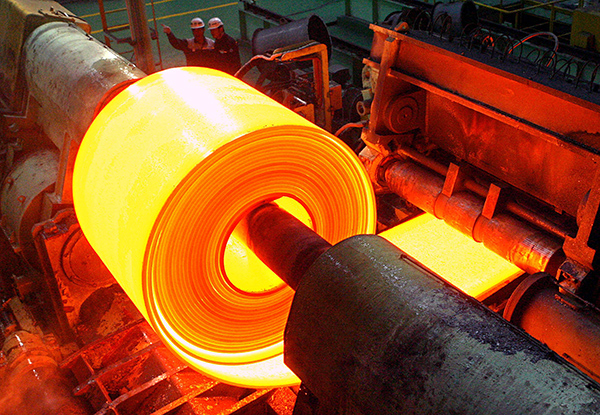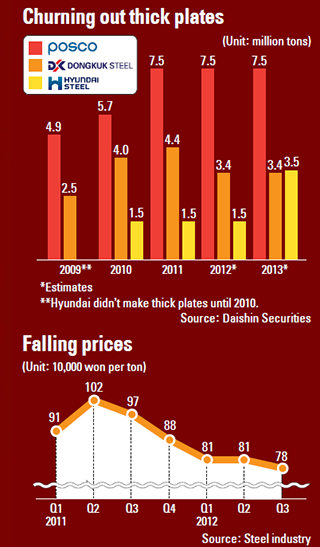Prices of steel plates hit rock bottom

The average price of thick steel plates, mainly used for ships, has hit a five-year low due to oversupply of steel amid the ongoing recession in the shipbuilding industry.
According to the steel industry this week, steelmakers lost ground to shipbuilders when negotiating steel prices for the third quarter. Shipbuilders demanded they lower the prices of their steel plates, saying the industry is suffering these days.
Steelmakers complain this is unfair.
“Shipbuilders asked the country’s major steelmakers - Posco, Hyundai Steel and Dongkuk Steel - to produce more thick steel plates when they were flying high in 2008 and2009,” said an industry insider. “So we built another plant to produce thick plates, but that has triggered a supply glut as the global financial crisis swept the shipbuilding industry and ship orders sharply declined last year.”
Shipbuilders succeeded in reducing the price of thick plates by 30,000 won ($27.70) per ton in the third quarter from the previous quarter, with the average price falling from 810,000 won to 780,000 won, according to a steel industry source. This is the first time it has dipped below 800,000 won mark in five years.
Thick plates are over six millimeters (0.2 inch) in width. Usually, local steelmakers and shipbuilders decide the price at the end of each quarter.
In the second quarter, the three major steelmakers refused to adjust the price.

“It was hard to maintain our stance due to the falling price of iron ore,” said the insider.
Meanwhile, shipbuilders grumble that the price is still too high.
“While the price of iron ore has fallen by more than 30 percent, the steel price has only dropped 3 percent,” said an employee at a local shipbuilder.
According to financial analysts, global demand for shipbuilding is forecast to keep shrinking until 2015. Korean shipbuilders are expected to experience falling orders until next year. The domestic market for thick plates is expected to hit a nadir in 2013.
“Until next year, shipbuilders will have an edge in price negotiations with steelmakers due to the falling demand,” said Jun Jae-chun, an analyst at Daishin Securities. “Since Hyundai Steel is scheduled to start running its third furnace in September, two million tons of thick plates will be added to the country’s total production capacity, which won’t help ease the oversupply problem.”
Current production capacity stands at 12.4 million tons, according to the Korea Iron & Steel Association. Domestic demand amounts to 9.4 million tons. Up to 40 percent of total production is exported overseas.
“Dongkuk Steel shut down an old thick plate plant early this year, while Posco is also gradually slashing production,” said a Posco employee.
Since October, Posco has started to reduce production of hot-rolled plates that are produced by electric furnaces. It remains to be seen whether production is scaled back on other lines.
This is the first time since the global financial crisis in 2008 that the country’s No. 1 steelmaker has been artificially adjusting production. Posco has activated its so-called S4 emergency response system, indicating the fourth-highest state of level.
By Song Su-hyun [ssh@joongang.co.kr]










with the Korea JoongAng Daily
To write comments, please log in to one of the accounts.
Standards Board Policy (0/250자)